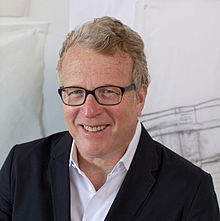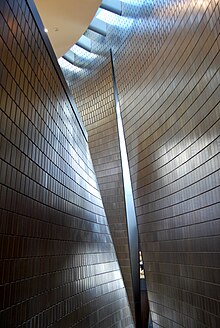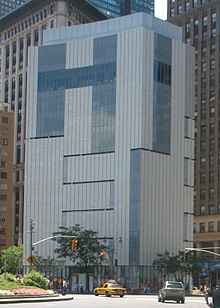| Revision as of 00:30, 26 April 2016 editAltamontstreet (talk | contribs)27 edits →Projects: attached current project photo← Previous edit | Revision as of 01:50, 27 April 2016 edit undoAltamontstreet (talk | contribs)27 edits Added portrait of article subjectNext edit → | ||
| Line 2: | Line 2: | ||
| {{Infobox architect | {{Infobox architect | ||
| |name = Brad Cloepfil | |name = Brad Cloepfil | ||
| |image = | |image = ] | ||
| |caption = | |caption = | ||
| |nationality = United States | |nationality = United States | ||
Revision as of 01:50, 27 April 2016
| Brad Cloepfil | |
|---|---|
 | |
| Born | 1956 Portland, Oregon |
| Nationality | United States |
| Alma mater | University of Oregon Columbia University |
| Occupation | Architect |
| Practice | Allied Works Architecture |
Brad Cloepfil (born 1956) is an American architect, educator and principal of Allied Works Architecture of Portland, Oregon and New York City. His first major project was an adaptive reuse of a Portland warehouse for the advertising agency Wieden+Kennedy. Since 2000, Cloepfil and Allied Works have completed cultural, commercial and residential projects including the Contemporary Art Museum St. Louis, the University of Michigan Museum of Art, the Dutchess County Residence Guest House and the Museum of Arts and Design. Recent and notable works include the Clyfford Still Museum in Denver, Colorado, completed in November 2011, and the National Music Centre of Canada in Calgary, Alberta, scheduled to open in July 2016.
Early life and education
Cloepfil was born in Portland, Oregon and earned his Bachelor of Architecture at the University of Oregon in Eugene. After working in the offices of Skidmore, Owings & Merrill, in Los Angeles, and Mario Botta, in Switzerland, Cloepfil moved to New York to earn his advanced degree in architectural design. He received his Master of Science in Advanced Architectural Design from the Columbia University Graduate School of Architecture in 1985.
Career
After a decade of teaching and practice in New York, California and Oregon, Cloepfil founded Allied Works Architecture in Portland, Oregon, in 1994, and opened the New York City office in 2003. Cloepfil has designed and realized a wide range of projects around the world, including civic and educational institutions, arts organizations and museums, and private residences. He has received acclaim for his work on creative and cultural projects and for crafting powerful spaces for art and interaction.
The recipient of numerous design awards, Cloepfil has held guest professorships at Columbia University, University of California, Berkeley, Rice University, Cornell University, Syracuse University, and the University of Oregon. He is also a frequent juror and lecturer at leading universities, arts organizations, and creative companies.
Projects

Allied Works is recognized for its cultural projects, among them the Clyfford Still Museum in Denver, Colorado, which has been acclaimed for its approach to light and space in showcasing the creative vision of a single artist. Additional prominent arts and educational projects include the Contemporary Art Museum St. Louis; the Museum of Arts and Design in New York; Seattle Art Museum; the University of Michigan Museum of Art; Booker T. Washington High School for the Performing and Visual Arts in the Dallas Arts District; and the Schnitzer Center for Art and Design at the Pacific Northwest College of Art in Portland, Oregon.
Allied Works has also designed and completed private residences, offices, and creative workspaces, such its design for Wieden + Kennedy Agency, which radically transformed an historic warehouse in Portland’s Pearl District into a world headquarters that has become a benchmark for adaptive reuse and workplace architecture; the Dutchess County Estate in Stanfordville, New York; and Pixar Animation Studios in Emeryville, California.
Major current projects include the National Music Centre of Canada, in Calgary, Alberta, which will be completed in 2016; a U.S. Embassy Compound in Maputo, Mozambique; the Veterans’ Memorial Museum in Columbus, Ohio; and studio and production spaces for Theory and Helmut Lang in New York City.
Wieden+Kennedy Building
Allied Works' first major commission for the Wieden+Kennedy Building was awarded after the co-founder Dan Wieden sought out the designer of a local Portland bar called Saucebox, which was one of Cloepfil's early tight-budget projects. The project transformed an abandoned 1908 warehouse into the headquarters for an international advertising agency. In a state of extreme disrepair after decades as a sealed cold-storage facility, Wieden had doubts of ever moving in there, but Cloepfil convinced him that it was worth the effort. The Allied Works design turned the dark warehouse into a light-filled, open structure with new concrete and reclaimed Douglas-fir juxtaposed against the existing masonry and heavy timber frame. This project earned him several other projects from Wieden and would prove to be instrumental in further commissions.
Contemporary Art Museum Saint Louis
Cloepfil's firm was selected in a 1999 design competition for the Contemporary Art Museum St. Louis over world-renowned architects such as Peter Zumthor, Herzog & de Meuron, and Rem Koolhaas. The museum was sited next to an existing Tadao Ando building for the Pulitzer Foundation and completed in 2003. The program of the museum was open-ended in the model of European Kunsthalls and does not own a collection. Describing his approach, Cloepfil said “I wanted a space that is energized on its own terms but also would be inspirational for artists. In a noncollecting context, you hope that artists are intensely motivated to generate work for the space."
Seattle Art Museum Expansion

When the Seattle Art Museum expansion committee was seeking an architect, it was the chief curator of architecture and design at the Museum of Modern art in New York, Terry Riley that suggested they consider Brad Cloepfil based on the work done on Wieden+Kennedy. In 2002, the Seattle Art Museum selected Allied Works for the expansion project, which more than doubled the museum's space, accommodated Robert Venturi's original design in 1991, and also included offices for Washington Mutual until the museum expands again. Allied Works was selected over other finalists Polshek Partnership and Cooper, Robertson & Partners.
Museum of Arts and Design
Main articles: 2 Columbus Circle and Museum of Arts and Design
Also in 2002, Cloepfil won the redesign of Edward Durell Stone's 2 Columbus Circle for the Museum of Arts and Design over architects Zaha Hadid, Toshiko Mori Architects, and Smith-Miller & Hawkinson Architects. Interest in landmarking this building began in 1996, soon after the building turned thirty years old and became eligible for landmark designation. In this year, Robert A. M. Stern included it in his article " A Preservationist's List of 35 Modern Landmarks-in-Waiting" written for the New York Times.
When the building was vacated by the NYC Convention and Visitors Bureau in 1998 it was neglected, and remained unoccupied until the right to redevelop the building was awarded to the American Craft Museum (now known as the Museum of Arts and Design). Years later, plans to alter the building were called the erasure "of a rare American modernist."
Cloepfil used the same massing and geometric shape as dictated by the city zoning regulations, and carved channels into the structure to bring in natural light. The redesigned building replaced the original white Vermont Marble with a glazed terra-cotta and glass facade. The aim behind the design was to underline the iconic presence of this 10-storey building and respond to the needs of the institution that will occupy it. The terra-cotta and glass covering evokes the principal theme of the collection, a look at different traditions in contemporary craft practice. The tiles were developed in collaboration with Dutch ceramics company Royal Tichelaar Makkum with a custom glaze by artist Christine Jetten.
The redesign of 2 Columbus Circle generated considerable attention and debate within the local community and architectural press, including opinion pieces written by Nicolai Ouroussoff, Ada Louise Huxtable, Paul Goldberger, Witold Rybczynski and Justin Davidson.
Clyfford Still Museum
In 2007, Cloepfil and Allied Works won the competition to design the Clyfford Still Museum, which is adjacent to Daniel Libeskind's design of the Denver Art Museum. Cloepfil says that his goal is to provide the visitors an intimate experience with the artist's life, work and creative vision. The museum opened to the public in 2011. The lower level houses the education, archive and storage spaces. In the upper level galleries, the visitor moves through a series of nine distinct volumes where they encounter the work of Clyfford Still. The galleries respond to the evolving character of Still’s art, changing scale and proportion, while varying the intensity of light. The museum is recognized as a successful implementation of contemporary architecture and an icon for the city of Denver.
Case Work exhibition
From January 24, 2016 to April 17, 2016, the Denver Art Museum hosted a temporary exhibit called "Case Work", which showcased the design process used for this museum and other major works by Allied and Cloepfil. After Denver, the exhibit is planned to show at the Portland Art Museum and then embark on a two-year international tour. Dean Sobel, director of the Clyfford Still Museum, is curator of the exhibit.
References
- Notes
- Blum, Andrew (July 25, 2007). "The Elementalist". Metropolis Magazine. Retrieved March 5, 2008.
{{cite web}}: Italic or bold markup not allowed in:|publisher=(help) - "About Allied Works Architecture". Allied Works Architecture. Allied Works Architecture. Retrieved October 4, 2011.
- "Cloepfil Bio". Allied Works Architecture.
- "Cloepfil Bio". Allied Works Architecture.
- "About Allied Works". Allied Works Architecture.
- ^ Farr, Sheila (December 4, 2005). "Museum Maker". The Seattle Times. Retrieved March 5, 2008.
- Libby, Brian (January 2, 2002). "Interview with an Emerging Architect". ArchitectureWeek. Retrieved March 1, 2008.
{{cite web}}: Italic or bold markup not allowed in:|publisher=(help) - Russel, James (January 2004). "Contemporary Art Museum St. Louis". Architectural Record. Retrieved March 5, 2008.
- Farr, Sheila (May 1, 2007). "With a new home and new art, will museum gain new profile?". The Seattle Times. Retrieved March 5, 2008.
{{cite web}}: Italic or bold markup not allowed in:|publisher=(help) - Czarnecki, John (October 18, 2002). "Allied Works to design Seattle Art Museum expansion". Architectural Record. Retrieved March 5, 2008.
{{cite web}}: Italic or bold markup not allowed in:|publisher=(help) - "A New Face at Columbus Circle, but the Lollipops Remain". The New York Times. May 1, 2008. Retrieved April 26, 2010.
- ArchDaily: AD Classics: 2 Columbus Circle / Edward Durell Stone & Associates by Denim Pascucci (13 February 2014)
- Hales, Linda (March 29, 2008). "At Columbus Circle, Going Round & Round Over a Building's Fate". Washington Post. Retrieved June 27, 2008.
{{cite news}}: Italic or bold markup not allowed in:|publisher=(help) - Template:Fajardo, Julio, and Mariana R. Eguaras. "Allied Works Architecture Museum of Arts and Design." New York Architecture = New York Architektur = Arquitectura De Nueva York. Barcelona: FKG, 2010. 60-65. Print.
- "Allied Works MAD description".
- Ouroussoff, Nicolai (September 26, 2008). "New York City, Tear Down These Walls". The New York Times. Retrieved September 28, 2008.
{{cite news}}: Italic or bold markup not allowed in:|publisher=(help) - Huxtable, Ada Louise (December 10, 2008). "Setting the Record Straight About Ed Stone and Brad Cloepfil". Wall Street Journal. Retrieved September 5, 2009.
- Goldberger, Paul (August 25, 2008). "Hello, Columbus". The New Yorker. Retrieved September 5, 2009.
- Rybczynski, Witold (January 14, 2009). "Goodbye, 2 Columbus Circle". Slate Magazine. Retrieved September 5, 2009.
- "Museum Date". New York Magazine. September 7, 2008.
- MacMillan, Kyle (November 27, 2006). "Clyfford Still Museum names Oregon firm to build in DAM's shadow". The Denver Post. Retrieved March 5, 2008.
{{cite web}}: Italic or bold markup not allowed in:|publisher=(help) - Hill, David (March 4, 2008). "Cloepfil Unveils Design for Clyfford Still Museum". Architectural Record. Retrieved March 5, 2008.
{{cite web}}: Italic or bold markup not allowed in:|publisher=(help) - "Clyfford Still Museum". Clyfford Still Museum. 2010. Retrieved October 17, 2010.
- "Allied Works_Still Description". Allied Works Architecture.
- ^ Rinaldi, Mark Ray (January 31, 2016). "Brad Cloepfil and Clyfford Still Museum make case for design in Denver". Lifestyles. Denver Post. Denver, Colorado. p. 1E. Archived from the original on January 31, 2016. Retrieved January 31, 2016.
- Allied Works Architecture (2016). Case Work Premieres at the Denver Art Museum
- Denver Art Museum (2016). Case Work: Studies in Form, Space & Construction by Brad Cloepfil / Allied Works Architecture, through April 17, 2016.
External links
- Official firm website of Allied Works Architecture
- Clyfford Still Museum publication on Hate Cantz website
- Allied Works Architecture / Brad Cloepfil: Occupation on Gregory R. Miller & co. website
- PORT review – drawings and models
- Missing the Marble at 2 Columbus Circle
Template:Architecture in Portland, Oregon
Categories: